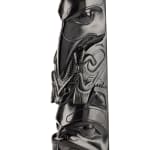-
Artworks
UNIDENTIFIED HAIDA ARTIST, SKIDEGATE, HAIDA GWAII
Model Totem Pole, c. 1910argillite, 13.25 x 3.25 x 3.25 in (33.7 x 8.3 x 8.3 cm)LOT 91
ESTIMATE: $8,000 — $12,000
PRICE REALIZED: $7,800.00Further images
-
(View a larger image of thumbnail 1
)

-
(View a larger image of thumbnail 2
)

-
(View a larger image of thumbnail 3
)

-
(View a larger image of thumbnail 4
)

-
(View a larger image of thumbnail 5
)

-
(View a larger image of thumbnail 6
)

-
(View a larger image of thumbnail 7
)

-
(View a larger image of thumbnail 8
)

This model pole is packed with detail into a limited space from top to bottom. The upper figure has a recurved beak and looks like an eagle, depicted as holding...This model pole is packed with detail into a limited space from top to bottom. The upper figure has a recurved beak and looks like an eagle, depicted as holding a whale whose head and body protrude from between the bird’s folded wings. The fact that it’s grasping a whale indicates the classic pairing of thunderbird and whale, though the bird’s head lacks the streaming feathers that often accompany the thunderbird image. The whale’s head slightly overlaps the head of the next figure down, a raven with a large frog in its mouth. The frog’s legs are lapped over the bird’s folded wings and its body obscures where the raven’s tail would be. The raven’s small feet occupy the triangular space between the edge of its wings and the top of the next figure’s ears, which is a beaver, seated in what is sometimes referred to as the hocker position. Its knees and elbows are drawn up, and its forepaws hold the minimal representation of a stick, one of the beaver’s traditional features. The mammal’s tail is turned up between its hind legs and features a humanoid face at the base and a small extension representing the textured surface of a beaver’s tail. The back of the pole is not hollowed out, following the later precept of a plain flat back. The pole is attached to a wide, square base with beveled sides all around. The profile view of this pole exhibits more overall depth in the sculpture, and a consequential irregularity of the figures’ forward limits, manifesting a deeper-than-wide proportion not contained in an originally cylindrical form. A similarly styled pole, undoubtedly by the same artist, is illustrated in Peter L. Macnair and Alan J. Hoover, The Magic Leaves: A History of Haida Argillite Carving, 2002 216, p. 136.
Steven C. Brown
References: See the section on late model poles in Peter L. Macnair and Alan J. Hoover, The Magic Leaves: A History of Haida Argillite Carving, (Victoria: Royal British Columbia Museum, 2002), pp. 127-138. See also Leslie Drew and Douglas Wilson, Argillite: Art of the Haida, (Vancouver: Hancock House Ltd., 1980), pp. 217-227.
Provenance
A Vancouver Collection. -
(View a larger image of thumbnail 1
)
Join our mailing list
* denotes required fields
We will process the personal data you have supplied in accordance with our privacy policy (available on request). You can unsubscribe or change your preferences at any time by clicking the link in our emails.








